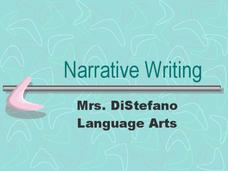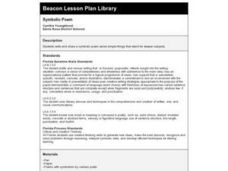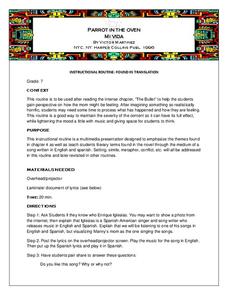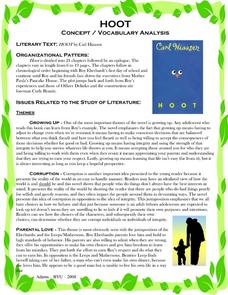Curated OER
Review of Literary Devices
Sixth graders review literary devices. They use both fiction and nonfiction texts to review metaphor, simile, alliteration, imagery, symbolism and personification. This instructional activity has a scripted guide for the teacher to follow.
Tech Coach Corner
Narrative Writing
A comprehensive presentation on narrative writing, this should be shown to a class before the writing process begins. There are not activities listed, so pupils can take notes on the elements of narrative writing and figurative language....
Curated OER
Writing a Literary Analysis
What makes writing literary? What comprises analysis? A 15-slide PowerPoint presentation, created by the Purdue University Writing Lab, tackles these questions. The explanations of what makes writing literary and what comprises analysis...
Shmoop
ELA.CCSS.ELA-Literacy.RL.11-12.6
It ‘s assessment check list time, and you have nothing to prove that your learners mastered the skill RL.11-12.6. Rest assured, here is a plan that is sure to appease your administrator. It offers solid examples on the difference...
Curated OER
Poetry: Basic Elements of a Poem
People who pen poetry positively need to know basic tenets and terms of poetry, like alliteration and consonance, for example. These and other terms are define and illustrated. Then viewers are given an object and asked to craft a...
Curated OER
"Black Boy"
Students read a series of sentences and decide what literary term is being shown. They also discuss a novel about prejudice.
Curated OER
Good Will - Three Chinese Stories
Young scholars listen to The Seven Chinese Brothers and identify tall tale elements in it. They brainstorm ways they could help each other in school. They create a banner reflecting the style and art of Chinese decorations and clothing...
Curated OER
Symbolic Poem
High schoolers read and analyze several highly symbolic poems. They create their own symbolic poem, read it to the class, and discuss whether they can guess any hidden meanings.
Curated OER
Music from a Place Called Half Moon
Learners read the novel, Music from a Place Called Half Moon. They are assigned chapters to analyze for literary elements and to assign titles to the book chapters.
Curated OER
The Use of Language in "I Know Why the Caged Bird Sings"
Readers of I Know Why the Caged Bird Sings are asked to craft an essay in which they compare how Maya Angelou uses figurative language to depict herself and Mrs. Flowers.
Curated OER
Parrot in the Oven: Instructional Routine
After reading "The Bullet," a particularly intense chapter in Victor Martinez's Parrot in the Oven: Mi Vida, class members listen to the Spanish and the English versions of "Dimelo" by Enrique Iglesias. They then discuss how the...
Florida Center for Reading Research
Vocabulary: Words in Context, Pun Fun
Scholars explore a variety of texts to locate wordplay. Partners read their selections and discuss meanings.
Curated OER
Hoot: Concept/Vocabulary Analysis
Augment your unit on Carl Hiaasen's Hoot with a series of activities about the environment, civil disobedience, making an impact in the world, and growing up. A list of literary concepts and themes helps you to write your lessons to...
Curated OER
Eng 312: Midsemester Exam
Using the text Language Awareness by Eschholz, Rosa and Clark, as well as previous lectures from the class, this slideshow presents students with a midterm addressing key terms and concepts. While teachers might have a hard time...
Curated OER
Idiom Quizzes - Animals
Following an exhaustive list of animal idioms, metaphors, and similes (categorized by animal), an online interactive quiz checks reader facility with their use. In each of 20 questions, a sentence has a definition for one expression in...
Curated OER
A Rose Is a Rose
Flowering learners explore the concept of figurative language as it relates to poems, songs, or creative written expression. In this creative writing lesson, they complete several phrases using similes, metaphors, and...
Curated OER
Reading the Play
Students read the play "Julius Caesar" by William Shakespeare. In groups, they identify the instances of similes, metaphors and personification. They use the Internet to compare and contrast the events in the play with historical facts....
Curated OER
Rock & Roll through Literary Terms: An Upbeat Lyrical Adventure
Students participate in a variety of activities surrounding Rock & Roll music, lyrics, drama and visual art and how they all help demonstrate examples of literary terms. They use Rock & Roll as an effective aid to stimulate their...
Curated OER
A Christmas Carol - Charles Dickens
Young scholars study and explore the portrayal and development of a major character in a novel from the novel, "A Christmas Carol," by Charles Dickens. They identify words and phrases that effectively describe the main character in this...
Curated OER
Our Unique Legacy of Giving
Middle schoolers view The Gift of All, a Community of Givers. In this philanthropic instructional activity, students discuss the gifts of philanthropists they've seen. Middle schoolers research and write a two page paper with four bullet...
Curated OER
Transcendentalism and Epiphany in Ray Bradbury's Dandelion Wine
Twelfth graders examine the characteristics of transcendentalism. In this transcendentalism lesson, 12th graders determine what this type of writing entails before reading a passage from, Ray Bradbury's, Dandelion Wine. They cite three...
Curated OER
Literary Analysis - Young Goodman Brown
Why is literary analysis so important? Readers explore writing a literary analysis by reviewing literary elements such as character, metaphor, plot, setting, simile, personification, and style. They read "Young Goodman Brown" by...
Curated OER
Watering Can
Pupils problem-solve a technique to pass pass a one gallon water container around a circle without using any hands or arms and making sure that everyone in the circle has touched the container. After several attempts, they reflect of the...
Curated OER
Presenting the Geologic Timescale
Students model the geologic timescale using distance as a metaphor for time. They write a summary of a major event or fossil organism. and station themselves and their summaries along a path within a gymnasium, and present their...

























